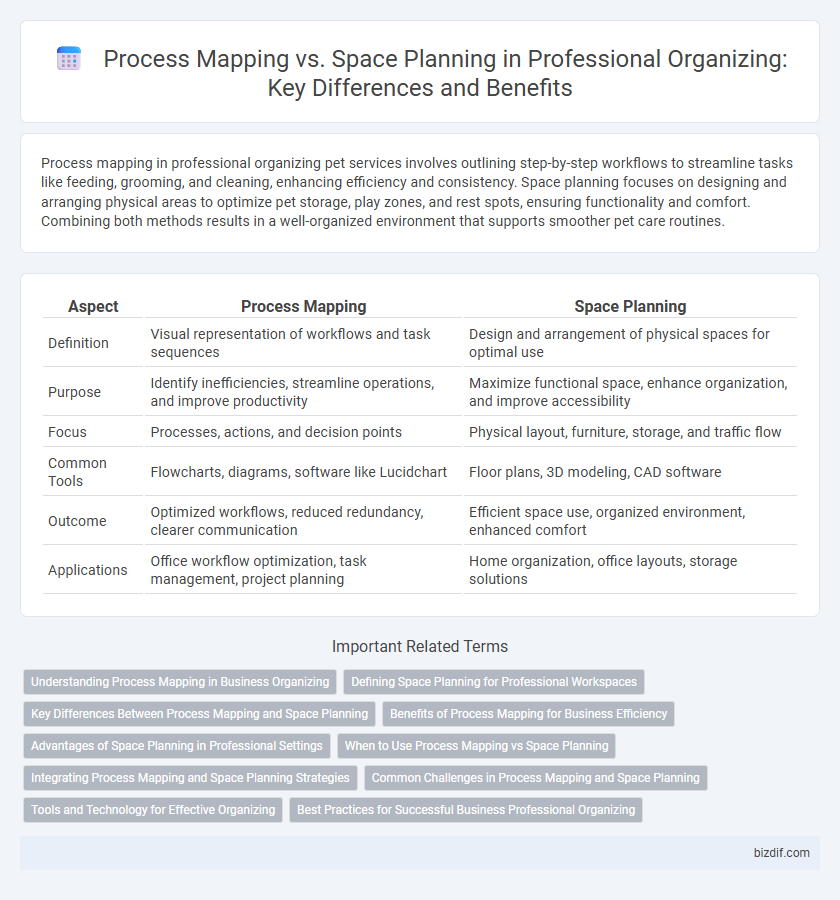Process mapping in professional organizing pet services involves outlining step-by-step workflows to streamline tasks like feeding, grooming, and cleaning, enhancing efficiency and consistency. Space planning focuses on designing and arranging physical areas to optimize pet storage, play zones, and rest spots, ensuring functionality and comfort. Combining both methods results in a well-organized environment that supports smoother pet care routines.
Table of Comparison
| Aspect | Process Mapping | Space Planning |
|---|---|---|
| Definition | Visual representation of workflows and task sequences | Design and arrangement of physical spaces for optimal use |
| Purpose | Identify inefficiencies, streamline operations, and improve productivity | Maximize functional space, enhance organization, and improve accessibility |
| Focus | Processes, actions, and decision points | Physical layout, furniture, storage, and traffic flow |
| Common Tools | Flowcharts, diagrams, software like Lucidchart | Floor plans, 3D modeling, CAD software |
| Outcome | Optimized workflows, reduced redundancy, clearer communication | Efficient space use, organized environment, enhanced comfort |
| Applications | Office workflow optimization, task management, project planning | Home organization, office layouts, storage solutions |
Understanding Process Mapping in Business Organizing
Process mapping in business organizing involves visually detailing workflows to identify inefficiencies and streamline operations, enhancing productivity and clarity. Unlike space planning, which focuses on physical layout optimization, process mapping emphasizes sequential task analysis and resource allocation. This method facilitates improved decision-making by revealing bottlenecks, redundancies, and opportunities for automation within business processes.
Defining Space Planning for Professional Workspaces
Space planning for professional workspaces involves strategically arranging physical areas to enhance functionality, productivity, and workflow efficiency. This process includes evaluating spatial dimensions, furniture placement, and circulation patterns to create an environment tailored to specific professional tasks and team dynamics. Unlike process mapping, which focuses on visualizing workflows and operational steps, space planning centers on optimizing the physical layout to support organizational goals and employee well-being.
Key Differences Between Process Mapping and Space Planning
Process mapping focuses on visualizing workflows and operational steps to enhance efficiency, while space planning centers on optimizing physical layouts to improve functionality and accessibility. Process mapping uses flowcharts and diagrams to identify bottlenecks and streamline tasks, whereas space planning employs spatial design principles to allocate and arrange physical spaces effectively. Both approaches aim to improve organization but differ in their emphasis on processes versus physical environments.
Benefits of Process Mapping for Business Efficiency
Process mapping enhances business efficiency by visually outlining workflows, identifying bottlenecks, and streamlining operations for better resource allocation. This method provides clarity on task sequences and interdependencies, enabling targeted improvements that reduce time waste and increase productivity. Unlike space planning, which optimizes physical layouts, process mapping directly improves procedural effectiveness and decision-making.
Advantages of Space Planning in Professional Settings
Space planning enhances workflow efficiency by strategically arranging furniture and equipment to optimize movement and accessibility in professional settings. It promotes better utilization of available space, reducing clutter and creating functional zones tailored to specific tasks. Implementing space planning also improves employee comfort and collaboration, leading to increased productivity and a more organized work environment.
When to Use Process Mapping vs Space Planning
Process mapping is ideal when optimizing workflows and task sequences to improve efficiency in professional organizing projects. Space planning becomes essential when the goal is to maximize the physical layout, ensuring optimal use of available areas for storage, movement, and accessibility. Choosing between process mapping and space planning depends on whether the primary challenge involves refining operational processes or enhancing spatial arrangements.
Integrating Process Mapping and Space Planning Strategies
Integrating process mapping and space planning strategies enhances professional organizing by aligning workflow efficiencies with physical layout optimization, resulting in streamlined operations and maximized space utilization. Process mapping identifies key task sequences and bottlenecks, while space planning translates these insights into functional environments tailored to specific activities. This synergy ensures that organizational systems not only support productivity but also foster a cohesive, efficient workspace design.
Common Challenges in Process Mapping and Space Planning
Common challenges in process mapping include identifying all workflow steps accurately, managing complex interdependencies, and ensuring stakeholder alignment to avoid process gaps or redundancies. Space planning difficulties often arise from balancing functional requirements with spatial constraints, maximizing usability while adhering to budget limits and regulatory codes. Both disciplines demand thorough analysis and collaboration to optimize efficiency and resource allocation effectively.
Tools and Technology for Effective Organizing
Process mapping utilizes digital tools like flowchart software and project management apps to visualize workflows, enhancing clarity and efficiency. Space planning relies on 3D modeling software and augmented reality tools to optimize physical layouts, ensuring functional and aesthetic organization. Integrating technology such as CAD programs and inventory management systems streamlines both process mapping and space planning, driving comprehensive and effective organizing solutions.
Best Practices for Successful Business Professional Organizing
Process mapping involves visually outlining each step of a business workflow to identify inefficiencies and improve productivity, while space planning focuses on optimizing physical layouts for functional and aesthetic efficiency. Best practices for successful business professional organizing include combining detailed process maps with strategic space planning to create environments that support streamlined operations and employee well-being. Data-driven adjustments, clear documentation, and continuous evaluation enhance organizational effectiveness and ensure sustainable growth.
process mapping vs space planning Infographic

 bizdif.com
bizdif.com